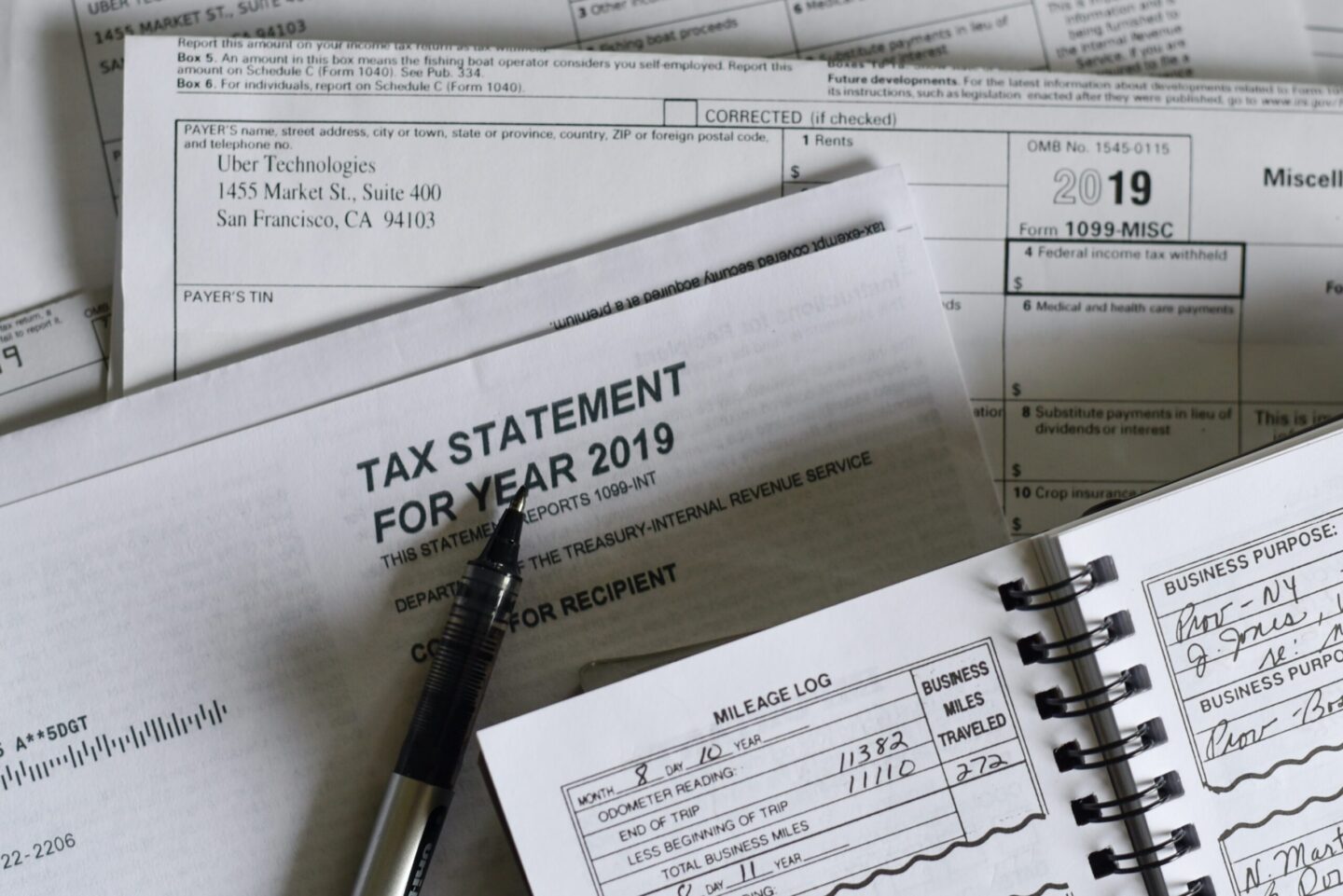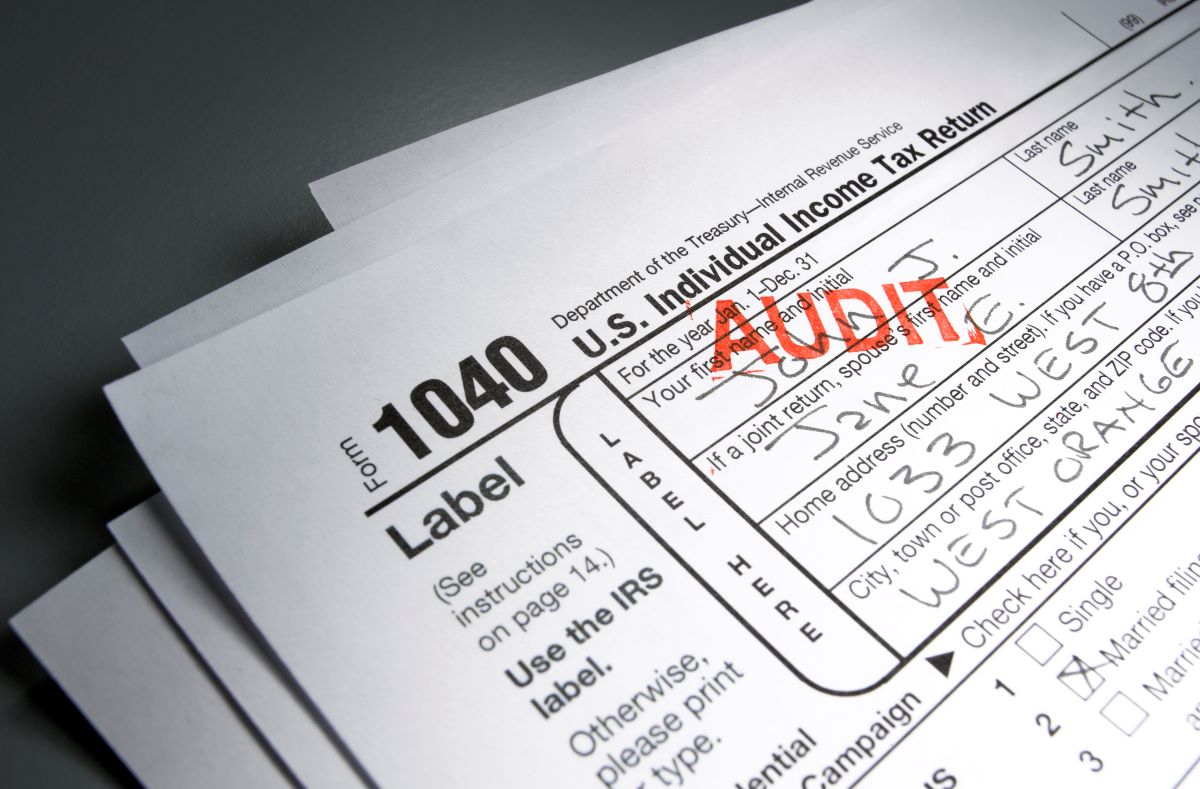

Finance
What To Do If The IRS Makes A Mistake
Published: October 31, 2023
Discover what steps to take if the IRS makes a finance-related mistake, ensuring your financial stability and resolving any potential issues effectively.
(Many of the links in this article redirect to a specific reviewed product. Your purchase of these products through affiliate links helps to generate commission for LiveWell, at no extra cost. Learn more)
Table of Contents
- Introduction
- Understanding IRS Mistakes
- Common Types of IRS Mistakes
- Steps to Take If the IRS Makes a Mistake
- Review the Notice or Correspondence
- Gather Relevant Documentation
- Contact the IRS
- Follow the Instructions Provided
- Seek Professional Help if Necessary
- Keep Records and Follow Up
- File an Appeal, if Applicable
- Understand the Resolution Process
- Request Penalty Abatement, if Appropriate
- Stay Informed and Updated
- Conclusion
Introduction
Dealing with taxes can be a complex and sometimes daunting task. And when the IRS makes a mistake in assessing your taxes or handling your case, it can create additional stress and confusion. However, it’s important to remember that the IRS is run by humans, and humans are prone to errors. Fortunately, there are steps you can take to rectify the situation and ensure that your tax matters are resolved accurately.
In this article, we will discuss what you should do if the IRS makes a mistake. Whether it’s an error in calculating your tax liability, incorrect information on your tax return, or a miscommunication in correspondence, understanding how to address these issues can help you navigate the situation with confidence.
It’s worth noting that the IRS has processes in place to rectify mistakes and provide a fair resolution. By being proactive and taking the necessary steps, you can work towards a favorable outcome and minimize any negative impact on your financial well-being.
In the sections that follow, we will explain the different types of mistakes the IRS may make, provide a step-by-step guide on what actions to take, and highlight important considerations throughout the process. It’s important to note that while this article aims to provide general guidance, each individual case may have unique aspects, and consulting a tax professional is always recommended for personalized advice.
Now, let’s delve deeper into the types of mistakes the IRS may make and how to address them efficiently and effectively.
Understanding IRS Mistakes
The Internal Revenue Service (IRS), as the federal agency responsible for tax administration in the United States, handles millions of tax returns and processes numerous financial transactions each year. Given the volume of work they manage, it’s not uncommon for mistakes to occur. Understanding the types of mistakes the IRS may make can help you navigate the situation more effectively.
IRS mistakes can range from simple clerical errors to more significant discrepancies in tax calculations or misinterpretation of the tax laws. Here are some common types of mistakes that individuals may encounter:
- Mathematical Errors: The IRS may make errors in performing calculations or transcribing data from tax returns, leading to incorrect amounts in your tax assessment.
- Incorrect Data Entry: Mistakes can happen when the IRS enters your personal information, such as your name, Social Security number, or address, into their system. These errors can result in issues with correspondence and proper identification.
- Tax Law Misinterpretation: The IRS employees are responsible for interpreting and applying the complex tax laws. In some cases, they may misinterpret or misapply the laws, resulting in errors in your tax assessment or determination of credits and deductions.
- Correspondence Errors: Errors in IRS correspondence can include incorrect information, inaccurate deadlines, or misunderstood requests. These mistakes can lead to confusion and delays in resolving tax-related matters.
- Identity Theft: Although not a mistake made by the IRS themselves, instances of identity theft can occur, where someone fraudulently uses your personal information to file taxes or claim refunds.
Understanding these common types of mistakes can help you identify and address any errors that may arise. It’s important to remember that mistakes can happen to anyone, and it’s not necessarily indicative of intentional wrongdoing by the IRS. With this knowledge in mind, let’s move on to the steps you can take if the IRS makes a mistake in your tax assessment or handling of your case.
Common Types of IRS Mistakes
When it comes to dealing with the Internal Revenue Service (IRS), mistakes can happen. The IRS is responsible for processing millions of tax returns and handling various tax-related matters each year, and with such a high volume of work, errors are inevitable. Understanding the common types of mistakes the IRS may make can help you be prepared and know how to address them.
Here are some of the most common types of IRS mistakes:
- Mathematical Errors: These are perhaps the most common mistakes made by the IRS. Errors in calculations can lead to incorrect tax assessments, causing potential discrepancies in the amount you owe or the refund owed to you.
- Data Entry Mistakes: The IRS handles a significant amount of data, and errors can occur when entering taxpayers’ information into their system. These mistakes can result in mix-ups with names, Social Security numbers, addresses, or other identifying information.
- Tax Law Interpretation Errors: The tax code is complex, and even expert tax professionals can sometimes interpret its provisions differently. When IRS agents interpret tax laws incorrectly, it can lead to errors in tax assessments, deductions, credits, or other tax-related matters.
- Correspondence Errors: Mistakes can also happen in IRS correspondence. Incorrect information, misunderstood requests, or missed deadlines can create confusion and potentially hinder the resolution of your tax matters.
- Identity Theft: While not an error made by the IRS themselves, instances of identity theft can occur. Scammers may use your personal information to file fraudulent tax returns or claim refunds, leading to complications and discrepancies in your tax records.
It’s important to mention that although these mistakes can be frustrating, they are often unintentional and can be rectified. The IRS has processes in place to address and correct errors to ensure fair and accurate tax assessments.
Now that you’re aware of the common types of IRS mistakes, it’s time to explore the steps you should take if you discover an error made by the IRS in your tax assessment or handling of your case. So, let’s move on to the next section to discuss the actions you should consider.
Steps to Take If the IRS Makes a Mistake
Discovering that the IRS has made a mistake in your tax assessment or handling of your case can be overwhelming. However, it’s crucial to take prompt action to rectify the situation. Here are the essential steps to follow if you find that the IRS has made a mistake:
- Review the Notice or Correspondence: Carefully read any notice or correspondence you received from the IRS regarding the mistake. Take note of the specific issue, the deadline for response, and any supporting documents requested.
- Gather Relevant Documentation: Collect all relevant documentation related to your tax situation. This includes tax returns, W-2 forms, 1099 forms, receipts, and any other supporting documents that can help validate your claims or clarify any discrepancies.
- Contact the IRS: Reach out to the IRS using the contact information provided in the notice or correspondence. Be prepared to provide your taxpayer identification number, the tax year in question, and any relevant case or reference numbers to help facilitate the resolution process.
- Follow the Instructions Provided: The IRS may provide specific instructions on how to proceed. It’s important to carefully follow these instructions to ensure that your concerns are addressed correctly and efficiently.
- Seek Professional Help if Necessary: Depending on the complexity of the issue and your comfort level with navigating the IRS processes, you may want to consider seeking professional help. Tax attorneys, certified public accountants (CPAs), or enrolled agents can provide expert guidance and representation during the resolution process.
- Keep Records and Follow Up: Maintain a record of all communication with the IRS, including dates, names of officials you’ve spoken to, and details of the conversation. This will help you keep track of the progress and ensure that all necessary steps have been taken.
- File an Appeal, if Applicable: If you disagree with the IRS’s decision and believe it to be incorrect, you have the right to file an appeal. The notice or correspondence you received will outline the appeal procedure and the deadline to file.
- Understand the Resolution Process: Familiarize yourself with the steps involved in the resolution process. This includes understanding how the IRS will review documentation, communicate their findings, and any further actions required from your end.
- Request Penalty Abatement, if Appropriate: If the mistake made by the IRS resulted in penalties or interest charges, and you believe they should be waived, you can file a penalty abatement request. Provide an explanation along with any supporting documentation to support your case.
- Stay Informed and Updated: Throughout the resolution process, stay informed about any updates or changes in your case. Respond promptly to any requests for additional information or documentation to avoid delays or potential complications.
By following these steps, you will be proactive in resolving the mistake made by the IRS and working towards an accurate and fair resolution. Keep in mind that each case is unique, and it’s recommended to consult with a tax professional for personalized advice that aligns with your specific circumstances.
Next, we’ll discuss in more detail the first step: reviewing the notice or correspondence received from the IRS. This will help you understand the specific issue at hand and provide insights into the necessary actions to take. So, let’s dive deeper into this process.
Review the Notice or Correspondence
When the IRS makes a mistake in your tax assessment or handling of your case, the first step you should take is to carefully review the notice or correspondence you received. This initial document is crucial as it provides essential information about the specific issue and outlines the steps you need to take to address it.
Here are some key points to consider during the review process:
- Understand the Issue: Read the notice or correspondence thoroughly to gain a clear understanding of the mistake the IRS has made. It may be related to a miscalculation of your tax liability or could involve incorrect data entry or misinterpretation of tax laws. By understanding the issue, you can better prepare yourself to address it.
- Take Note of Deadlines: Look for any deadlines mentioned in the notice or correspondence. The IRS typically provides a specific timeframe within which you need to respond or take action. Failing to meet these deadlines can have consequences, such as penalties or a loss of appeal rights.
- Identify Supporting Documentation: Note any supporting documentation requested by the IRS. This may include copies of your tax returns, W-2 forms, 1099 forms, receipts, or other relevant records. Gathering these documents in advance will help streamline the resolution process.
- Pay Attention to Contact Information: The notice or correspondence will provide contact information for the IRS office handling your case. Take note of the specific phone number, address, or email address you need to use to communicate with the IRS regarding the mistake. Using the correct contact information ensures that your inquiries and responses reach the appropriate department.
- Seek Clarification if Needed: If any part of the notice or correspondence is unclear or confusing, don’t hesitate to seek clarification. You can contact the IRS using the provided contact information or consult with a tax professional who can guide you through the process.
Reviewing the notice or correspondence from the IRS is crucial as it sets the foundation for the subsequent steps you need to take. By fully understanding the issue, deadlines, and required documentation, you can proceed with confidence and ensure that your case is addressed appropriately.
Once you have thoroughly reviewed the notice or correspondence and have a clear understanding of the issue at hand, you can move on to the next steps, which involve gathering relevant documentation and contacting the IRS. These steps will be covered in the following sections.
Gather Relevant Documentation
After reviewing the notice or correspondence from the IRS regarding the mistake they made, the next step is to gather all the relevant documentation related to your tax situation. These records will help validate your claims, clarify any discrepancies, and support your case when addressing the IRS.
Here are some key points to consider when gathering the necessary documentation:
- Tax Returns: Collect copies of the tax returns relevant to the issue at hand. This includes the original return that the IRS may have made a mistake in assessing, as well as any subsequent amended returns you may have filed.
- Income Statements: Gather supporting documents such as W-2 forms, 1099 forms, and any other statements that reflect your income for the tax year in question. These documents are essential for verifying the accuracy of the income reported on your tax return.
- Expense Receipts: Keep track of receipts for expenses claimed on your tax return. This includes receipts for deductible expenses, such as medical bills, educational expenses, business expenses, or charitable donations.
- Financial Statements: If the issue involves financial transactions or investments, gather relevant financial statements, such as bank statements, brokerage statements, or property records. These statements can help clarify any discrepancies or errors in the IRS’s assessment.
- Supporting Documents: Include any other supporting documents that are pertinent to the issue. This could include contracts, agreements, legal documents, or any other paperwork that is relevant to your tax situation.
Organize your documentation in a logical and orderly manner, making it easier for you to reference and present the necessary information when communicating with the IRS. By having all the relevant records readily available, you will be better equipped to support your claims and address any mistakes made by the IRS.
It’s important to note that while gathering documentation, it’s best to make copies and retain the originals for your records. This ensures that you have backup documentation if needed in the future and helps maintain a clear and organized record of your tax affairs.
Now that you have gathered all the necessary documentation, you are ready to move on to the next step: contacting the IRS. This step will be covered in the following section.
Contact the IRS
Once you have reviewed the notice or correspondence from the IRS and gathered all the relevant documentation, the next step is to contact the IRS. Direct communication with the IRS is crucial in addressing the mistake they made and resolving the issue at hand.
When contacting the IRS, there are a few important points to keep in mind:
- Use the Correct Contact Information: Refer to the notice or correspondence you received to find the specific contact information for the IRS office handling your case. This may include a phone number, mailing address, or email address. Ensure that you use the correct contact information to reach the appropriate department and facilitate efficient communication.
- Prepare Your Information: Before contacting the IRS, gather all relevant information, including the notice or correspondence, your taxpayer identification number, the tax year in question, and any case or reference numbers provided. Having this information readily available will help streamline the conversation and ensure that the IRS has all the necessary details on hand.
- Plan Your Communication Method: Determine the most suitable method of communication for your situation. This can be a phone call, written letter, or email, depending on the instructions provided by the IRS. Be prepared to wait on hold or for a response, as reaching the IRS may involve some wait time or processing time.
- Be Clear and Concise: When communicating with the IRS, be clear and concise about the issue at hand. Explain the mistake they made, provide relevant details and supporting documentation, and clearly state the desired resolution. Avoid unnecessary details or lengthy explanations that can potentially confuse or distract from the main point.
- Stay Calm and Professional: It’s essential to maintain a calm and professional demeanor when interacting with the IRS. Keep in mind that the representative you’re speaking with is there to assist you, and politeness can go a long way in facilitating a favorable outcome. Even if you are frustrated or upset, try to remain respectful and focused on addressing the issue.
By contacting the IRS and initiating the conversation, you take an active role in resolving the mistake made by them. Be prepared to provide the necessary information, answer any questions they may have, and follow their instructions on how to proceed.
In some cases, the issue may be resolved during the initial contact with the IRS. However, depending on the complexity of the situation, multiple interactions with the IRS may be necessary. Keep detailed records of all communications, including dates, names of officials you’ve spoken to, and a summary of the conversation. These records will be vital for tracking the progress and ensuring that all necessary steps are taken to address the mistake made by the IRS.
In the next section, we will discuss the importance of following the instructions provided by the IRS. This will help ensure that you take the appropriate actions to resolve the issue effectively.
Follow the Instructions Provided
After contacting the IRS regarding the mistake they made, it’s essential to carefully follow the instructions provided by the IRS. These instructions are typically outlined in the notice or correspondence you received and will guide you on how to proceed with resolving the issue.
Here are some important points to consider when following the instructions provided by the IRS:
- Read and Understand: Carefully read and understand the instructions provided by the IRS. Take note of any specific actions you need to take, deadlines you need to meet, or documents you need to submit. Understanding the instructions fully will help you navigate the resolution process effectively.
- Document Checklist: Create a checklist based on the instructions to ensure that you complete all the required steps. Having a checklist will help you stay organized and keep track of your progress as you fulfill each requirement.
- Submit Documentation: If the instructions require you to submit documentation or additional information, ensure that you do so in a timely manner. Follow the guidelines provided on how to submit the documents – whether it’s by mail, fax, or through an online portal.
- Adhere to Deadlines: Pay close attention to any deadlines mentioned in the instructions. Missing deadlines can have severe consequences, including penalties or a loss of appeal rights. Set reminders for yourself and ensure that you submit all required information within the specified timeframe.
- Double-Check Accuracy: Before submitting any documentation or responding to the IRS, double-check the accuracy of the information provided. Make sure that all the details and figures are correct, and review your supporting documentation for completeness.
- Seek Clarification if Needed: If any portion of the instructions is unclear or if you need further clarification, don’t hesitate to seek help. Contact the IRS using the provided contact information or consult with a tax professional who can guide you through the process.
Following the instructions provided by the IRS is crucial to ensure that you meet their requirements and properly address the mistake they made. Failure to follow the instructions may result in delays or complications in resolving the issue.
Remember to keep a record of all the actions you take, including dates, times, and the specific steps you’ve completed. These records will be valuable for reference purposes and can be helpful if you encounter any further issues or need to provide evidence of your compliance with the instructions.
Continue to the next section to learn about seeking professional help if necessary. While not always required, professional assistance can provide additional guidance and expertise in navigating the IRS resolution process.
Seek Professional Help if Necessary
Resolving a mistake made by the IRS can sometimes be a complex and challenging process. If you find yourself struggling to navigate the IRS procedures or are facing a particularly complicated issue, it may be beneficial to seek professional help from a tax attorney, certified public accountant (CPA), or enrolled agent.
Here are some factors to consider when deciding whether to seek professional assistance:
- Complexity of the Issue: Assess the complexity of the mistake made by the IRS. If the issue involves complex tax laws, extensive financial transactions, or legal implications, professional help can provide you with the expertise needed to navigate through the intricacies.
- Expert Guidance: Professionals in tax law and accounting are well-versed in IRS processes and regulations. They can guide you through the resolution process, ensure that your rights are protected, and help you understand your options for addressing the mistake made by the IRS.
- Representation and Communication: In some cases, it may be beneficial to have a professional represent you in your dealings with the IRS. They can communicate with the IRS on your behalf, ensuring that your concerns are effectively communicated and properly addressed.
- Mitigating Potential Risks: If the mistake made by the IRS carries potential financial consequences or other risks, seeking professional assistance can help mitigate these risks. Professionals can help you develop strategies to minimize penalties, negotiate settlements, or explore options for relief.
- Time and Effort: Resolving an IRS mistake can be time-consuming and involve significant effort. If you have limited time or resources to dedicate to the resolution process, professionals can lighten the burden by taking on the necessary tasks and providing comprehensive support.
When seeking professional help, be sure to choose a reputable and experienced tax professional who has expertise in dealing with IRS matters. Interview potential candidates, inquire about their experience and track record, and consider seeking referrals from trusted sources.
Keep in mind that seeking professional assistance may involve additional fees, so it’s important to consider the potential cost in relation to the potential benefits. In some cases, the investment may be well worth it in terms of time saved, expertise gained, and the potential for a more favorable resolution.
Ultimately, the decision to seek professional help is a personal one. Assess your specific situation, consider the complexity of the issue, and weigh the potential advantages and disadvantages before making a decision.
In the next section, we will discuss the importance of keeping records and following up during the resolution process.
Keep Records and Follow Up
As you navigate the process of resolving a mistake made by the IRS, it’s crucial to keep detailed records and consistently follow up on your case. This helps you stay organized, tracks your progress, and ensures that all necessary steps are taken to address the issue effectively.
Here are some key points to consider when keeping records and following up:
- Record Every Interaction: Make a record of each interaction you have with the IRS, including phone calls, emails, letters, and in-person meetings. Note the date, time, the name of the IRS representative, and a summary of the conversation. These records will serve as a reference point for future communications and help you track the progress of your case.
- Maintain Copies of Documentation: Make copies of all documents you submit to the IRS, as well as any documents they provide to you. This includes tax returns, supporting documentation, letters, notices, and any other paperwork related to your case. Keeping copies helps you retain a clear record of the information exchanged between you and the IRS.
- Establish a System: Develop an organized system for storing and accessing your records. Whether it’s a physical filing system or a digital folder, ensure that it is easy to navigate and labeled appropriately. This will save you time and frustration when you need to retrieve specific documents or correspondence.
- Follow Up Promptly: If the IRS requests additional information or documentation from you, make it a priority to respond promptly. Delaying your response can result in delays in the resolution process and potentially lead to further complications. Set reminders for yourself and track any deadlines to ensure timely follow-up.
- Document Delivery Methods: Keep a record of the method through which you deliver documents to the IRS, whether it’s by mail, fax, email, or through an online portal. This documentation serves as proof of submission and can be useful if any discrepancies or disputes arise in the future.
- Request Confirmation: When sending important documents or correspondence to the IRS, consider using registered mail or obtaining proof of delivery. This ensures that you have evidence of submission and can track the receipt of your materials by the IRS.
- Stay Up to Date: Regularly check the status of your case with the IRS. If there are any updates or developments, it’s essential to promptly address them. Monitor your mailbox for any new notices or correspondence from the IRS and respond accordingly.
By keeping accurate records and following up diligently, you demonstrate your commitment to resolving the mistake made by the IRS. These records also provide you with a comprehensive overview of the resolution process, making it easier to track the progress of your case and ensure that all necessary steps have been taken.
In the next section, we will discuss the option of filing an appeal if you disagree with the IRS’s decision. This is an important avenue to consider if you believe that the mistake made by the IRS has not been adequately addressed.
File an Appeal, if Applicable
If you disagree with the decision made by the IRS or believe that the mistake they made has not been adequately resolved, you have the right to file an appeal. Filing an appeal allows you to challenge their decision and seek a fair resolution to the issue.
Here are some important points to consider when filing an appeal:
- Review the Notice: Carefully review the notice or correspondence you received from the IRS regarding their decision. Note the specific reason for the decision and any instructions provided on how to proceed with the appeal process.
- Evaluate the Merits: Assess the merits of your case and determine if filing an appeal is appropriate. Take into account the evidence you have, the applicable tax laws, and any expert opinions or professional advice you have received.
- Adhere to Deadlines: Pay close attention to the deadline for filing an appeal. It’s usually stated in the notice or correspondence received from the IRS. Missing the deadline may result in the loss of your right to appeal, so ensure that you submit your appeal within the specified timeframe.
- Complete IRS Forms: The IRS typically requires specific forms to be completed when filing an appeal. Familiarize yourself with the required forms, such as Form 12203, Request for Appeals Review, and ensure that you provide accurate and detailed information.
- Provide Supporting Documentation: Include all relevant supporting documentation when filing your appeal. This may include copies of tax returns, financial statements, correspondence with the IRS, or any other evidence that supports your case. Be thorough and organized in presenting your arguments.
- Explain Grounds for Appeal: Clearly state the grounds for your appeal and provide a well-reasoned argument. Address each issue or mistake made by the IRS that you are disputing and explain why you believe their decision was incorrect or unfair.
- Submit Your Appeal: File your appeal with the appropriate IRS office or follow the specific instructions provided in the notice or correspondence. Ensure that you keep a copy of your appeal and any supporting documentation for your records.
- Be Prepared for the Appeals Process: Understand that the appeals process may involve additional communication and negotiation with the IRS. Be prepared to present your case and potentially participate in settlement discussions or hearings. Consider seeking professional representation to navigate the appeals process effectively.
Keep in mind that filing an appeal provides an opportunity for an impartial review of your case by an IRS appeals officer. They will assess the information presented, review the relevant facts and laws, and potentially offer a resolution or settlement.
If you are not satisfied with the outcome of the appeals process, you may have further options, such as requesting mediation or pursuing litigation. Consulting with a tax professional during the appeals process can provide valuable guidance and help you explore all available options.
In the next section, we will discuss the resolution process and the importance of understanding the steps involved to reach a final outcome.
Understand the Resolution Process
When addressing a mistake made by the IRS, it’s crucial to have a clear understanding of the resolution process. Familiarizing yourself with the steps involved can help you navigate the process effectively and work towards a fair and satisfactory outcome.
Here’s an overview of the general resolution process:
- Initial Contact: The process begins with your initial contact with the IRS, whether it’s through a notice, correspondence, or direct communication. This is where the mistake or issue is identified.
- Review and Response: After you have reviewed the notice or correspondence, gathered relevant documentation, and contacted the IRS, they will review your case. They may request additional information or documentation from you before proceeding.
- Resolution Attempts: The IRS will work towards resolving the mistake through various methods, including recalculating your tax liability, correcting errors, or offering an adjustment. They may also propose a settlement or alternative resolution options.
- Negotiation and Communication: Throughout the resolution process, there may be further communication and negotiation between you and the IRS. This can involve clarifying information, answering inquiries, providing additional documentation, or participating in settlement discussions.
- Appeals Process: If you are not satisfied with the resolution offered by the IRS, you have the option to file an appeal. This allows for an independent review of your case by an IRS appeals officer who will consider the facts, evidence, and applicable laws.
- Final Decision: Once all necessary steps, including any appeals, have been completed, the IRS will reach a final decision. They will provide you with their determination of the mistake made and any further actions required from your end.
- Implementation and Compliance: If the IRS’s final decision is in your favor, they will implement the necessary changes, including adjusting your tax liability, refund, or other required actions. It’s important to comply with any instructions provided to ensure a smooth resolution.
Understanding the resolution process helps you anticipate the steps involved, manage expectations, and actively participate in the process. It enables you to provide the necessary information, comply with deadlines, and advocate for a fair outcome.
Throughout the resolution process, maintain open and clear communication with the IRS. Keep records of all interactions, follow up on any outstanding matters, and seek clarification if needed. Having a grasp of the process and actively engaging in it empowers you to address the mistake made by the IRS effectively.
In the next section, we will discuss the option of requesting penalty abatement if appropriate in your situation.
Request Penalty Abatement, if Appropriate
If the mistake made by the IRS resulted in penalties or interest charges, and you believe that they should be waived or reduced, you have the option to request penalty abatement. Penalty abatement is a process through which the IRS may forgive or lower the penalties imposed.
Consider the following steps when requesting penalty abatement:
- Evaluate Eligibility: Determine if you meet the criteria for penalty abatement. In general, the IRS considers factors such as reasonable cause, first-time penalty abatement, or administrative waivers. Consult the IRS guidelines or seek professional advice to assess your eligibility.
- Understand Reasonable Cause: If your mistake or noncompliance was due to circumstances beyond your control, such as a serious illness, natural disaster, or death in the family, you may qualify for penalty abatement based on reasonable cause.
- Research First-Time Penalty Abatement: The IRS offers a first-time penalty abatement (FTA) option for eligible taxpayers who have a good compliance history. If you have not previously incurred penalties, you may qualify for the FTA program.
- Prepare Documentation: Gather supporting documents that demonstrate your reasonable cause or eligibility for penalty abatement. This may include medical records, death certificates, police reports, or other evidence that substantiates your claim.
- Write a Clear and Concise Letter: Draft a letter to the IRS requesting penalty abatement. Clearly explain the circumstances, provide relevant details, and attach the supporting documentation. Be honest and persuasive in presenting your case.
- Submit the Request: Send your penalty abatement request to the appropriate IRS office, following the instructions provided in the notice or correspondence. Make sure to keep a copy of your request and any supporting documents for your records.
- Follow Up: If you don’t receive a response from the IRS within a reasonable timeframe, follow up on your penalty abatement request. Contact the IRS using the provided contact information and inquire about the status of your request.
Requesting penalty abatement can be a valuable option to alleviate the financial burden associated with penalties or interest charges resulting from the mistake made by the IRS. It’s important to carefully evaluate your eligibility and provide a compelling argument supported by appropriate documentation.
Remember that penalty abatement is not guaranteed, and the IRS will assess your request based on your specific circumstances. Consider seeking professional assistance to increase your chances of a successful outcome or to explore other potential avenues for penalty relief.
In the final section, we will discuss the importance of staying informed and updated throughout the resolution process.
Stay Informed and Updated
Throughout the resolution process of addressing a mistake made by the IRS, it’s crucial to stay informed and updated. By staying actively engaged and well-informed, you can effectively navigate the process, respond to inquiries or requests in a timely manner, and work towards a favorable resolution.
Here are some important points to consider about staying informed and updated:
- Monitor Your Mail: Regularly check your mailbox for any new notices, correspondence, or updates from the IRS. Timely response to their communications is vital to avoid potential delays or complications in resolving the issue.
- Respond Promptly: If the IRS requests additional information, documentation, or clarification, respond promptly. Delayed responses can lead to unnecessary delays in the resolution process and may potentially impact the outcome.
- Keep Contact Information Current: Ensure that the IRS has your correct contact information. If there are any changes to your address, phone number, or email address, notify the IRS promptly to avoid any miscommunications.
- Stay Updated on IRS Policies and Guidelines: Familiarize yourself with the latest IRS policies, guidelines, and updates that may impact your case. This can include changes in tax laws, penalty abatement requirements, or relevant IRS publications. The IRS website and tax resources can be valuable sources of information.
- Track Deadlines and Timeframes: Maintain a calendar or use reminders to track important deadlines and timeframes associated with your case. This includes deadlines for submitting documentation, filing appeals, or responding to IRS inquiries. Meeting these deadlines is essential to ensure a smooth resolution process.
- Seek Professional Advice: If you’re uncertain about any aspect of the resolution process or have concerns, consider seeking professional advice. Tax attorneys, certified public accountants (CPAs), or enrolled agents can help you stay informed and provide guidance tailored to your specific situation.
- Follow News and Updates: Regularly keep up with tax-related news and updates. This includes changes in tax laws, IRS procedures, or any updates that may impact your case. Staying informed allows you to adapt your approach and take advantage of any relevant opportunities or provisions.
- Maintain Communication Records: Keep accurate records of your communications with the IRS, including dates, times, names of representatives you’ve spoken with, and summaries of the conversation. These records serve as a valuable resource for reference and documentation throughout the resolution process.
By staying informed and updated, you empower yourself to actively participate in the resolution of the mistake made by the IRS. It helps you understand your rights, comply with the requirements, and adapt to any changes that may arise during the process.
Remember that the IRS resolution process can sometimes take time, so patience and persistence are key. Stay engaged, follow the necessary steps, and advocate for a fair and accurate resolution to the mistake made by the IRS.
With these ten steps and a proactive approach, you can effectively address the mistake made by the IRS and work towards a satisfactory outcome. Always consult with a tax professional for personalized advice that takes into account your specific circumstances.
Remember, each individual case may have unique aspects, and the information provided in this article should be used as general guidance and not considered as a substitute for professional advice.
Now, armed with this knowledge, you are better prepared to handle and resolve any mistakes made by the IRS with confidence and efficiency.
Conclusion
Dealing with a mistake made by the IRS in your tax assessment or handling of your case can be a challenging and stressful experience. However, by following the appropriate steps and staying informed, you can effectively address the issue and work towards a fair resolution.
In this article, we have explored ten essential steps to take if the IRS makes a mistake:
- Review the Notice or Correspondence
- Gather Relevant Documentation
- Contact the IRS
- Follow the Instructions Provided
- Seek Professional Help if Necessary
- Keep Records and Follow Up
- File an Appeal, if Applicable
- Understand the Resolution Process
- Request Penalty Abatement, if Appropriate
- Stay Informed and Updated
Each step plays a crucial role in navigating the resolution process and ensuring that your concerns are properly addressed. It’s important to remember that seeking professional assistance, when necessary, can provide valuable guidance and increase your chances of a successful outcome.
Additionally, maintaining accurate records, following up on communications, and staying informed about IRS policies and guidelines are essential for effectively advocating for a fair and accurate resolution.
Remember, the information provided in this article is for general guidance and should not replace personalized advice from a tax professional. Each case is unique, and consulting with an expert can provide tailored advice based on your specific circumstances.
Resolving a mistake made by the IRS may require time, patience, and persistence. Stay proactive, comply with deadlines, and be open to negotiation or alternative resolution options when available.
By taking the appropriate steps, staying informed, and seeking professional guidance when needed, you can successfully navigate the process and work towards a favorable resolution of the mistake made by the IRS.
With diligence and the right approach, you can ensure your tax matters are accurately assessed and resolved, providing you with peace of mind and financial stability.














